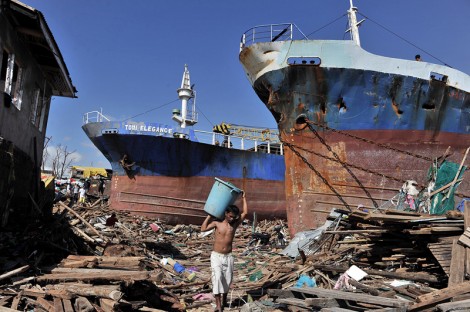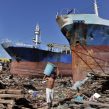
Philippine Military Modernization More Urgent and Less Likely after Hurricane
Publication: China Brief Volume: 13 Issue: 24
By:

Typhoon Haiyan, known as Yolanda in the Philippines, killed 5,719 and injured 26,233 and displaced more than four million people (ndrrmc.gov.ph, December 4; Manila Bulletin, November 20). This is more than 4% of the country’s total population. To put this into perspective, by comparison, approximately one million people were displaced by Hurricane Katrina, and 320,000 in Japan after the 2011 Tsunami. The typhoon followed on the heels of the magnitude 7.2 earthquake that hit the south central provinces of Cebul and Bohol, which according to official government figures killed 222 people (ndrrmc.gov.ph, Nov 3, 2013).
The international community has been quick to provide significant assistance to the Philippines. This outpouring of aid is all the more necessary because of the Philippine’s weak military and logistic capabilities. Furthermore, the fragmented nature of the Philippine Archipelago, and internal politics and turf wars have proved a major issue in the distribution of supplies to the effected areas (Philippine Star, November 11). A larger issue, however looms, on the horizon.
The Philippines have an ongoing territorial dispute with China over the Nansha, or Spratly, Islands (China Brief, April 26, 2012). Following the typhoon, the Philippines’ ability to defend their territorial claims is perhaps at its weakest state yet. With China’s establishment of an Air Defense Identification Zone (ADIZ) covering the disputed Senkaku/Diaoyu islands, there is a strong chance that similar moves could be made to further entrench Chinese pressure in the region (see this issue of China Brief for further coverage of the new ADIZ).
Modernization in slow motion
With immense demands being made on mostly older planes and ships for rescue efforts, even routine surveillance flights and visits to Philippine borders will likely see significant decreases. The Philippines maintain a token presence of several Marines on the Second Thomas Shoal, in a rusty landing craft deliberately run aground (“Second Thomas Shoal Likely the Next Flashpoint in the South China Sea,” China Brief, June 21). Already facing harsh living conditions and a tense military situation, with fewer governmental resources available these soldiers are likely to face even harder deployments in the future. Despite their domestic predicament, the Philippine government has recently committed $11.2 million for upgrades to military facilities in the area to shore up infrastructure (Kyodo News, December 4). However, accidents have reduced the antiquated jet fleet that has been used to patrol the area to just three aircraft (Reuters, October 22, 2008; GMA News, June 30).
Attempts to upgrade the Philippines forces are likely to run into budgetary obstacles in the near future. Competition for resources between government departments in the wake of the typhoon has already begun–in this case, the Philippine Air Force (PAF) and the Department of Social Welfare and Development (DSWD). The "turf war" had to do with DSWD use of Villamor air base, a key facility of the PAF (Philippine Star, November 21).
With these issues, it is uncertain how the typhoon and rebuilding efforts will affect the recently announced purchase of eight AugustWestland AW109 Power helicopters for $80 million USD (Philippine Star, October 28; AugustWestland.com, November 6). Such helicopters would have been invaluable in providing logistical support in preparation for and dealing with the aftermath of the typhoon, but such purchases might be harder to justify when accepting cash from foreign donors.
Humanitarian Response
China’s response to the humanitarian crisis was at first muted, surprising many, even within China. The typhoon received very little in terms of coverage by media outlets, and the Chinese government initially only offered $100,000 in aid, somewhat less even than the $350,000 put up by the band Journey (The Straits Times, November 13; Rolling Stone, November 16).
Likely responding to this criticism, China increased the amount of aid to about $1,640,000 on November 14 and deployed a military hospital ship, the Peace Ark, on November 21 (Xinhua, November 20; November 25). Doctors and rescue personnel associated with the Peace Ark have subsequently treated 1,000 patients (China Daily, December 3). Photos show navy personnel and Z-8 helicopters deployed.
From the Chinese position, any aid to the Philippines is fraught with political complications. Providing aid is an opportunity for China to demonstrate grace to a much weaker opponent, and also to undermine the Philippines position when attempting to garner support against China. However, it does place the Chinese Foreign Ministry in the unusual situation of donating to an organization (the National Disaster Risk Reduction and Management Council or NDRRMC) officially headed by the Defense Secretary of a nation with whom they have an ongoing dispute.
Allies and the way forward
All indications point to the Philippine armed forces and aid workers facing an enormous task, particularly given the logistical challenges of the thousands of islands they operate across and the large swaths of cities destroyed and with degraded transport capabilities. The speed with which the nation can recover, and the degree to which it can rebuild infrastructure while continuing to build its armed forces, however, will have an important effect on the balance of power in Southeast Asia. This will strongly depend on the degree of response by Japan the United States.





